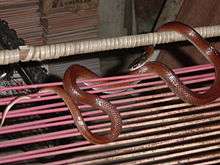Pseudoboa neuwiedii
Pseudoboa neuwiedii, commonly known as the ratonel or ratonera (mouse-eater), is a species of snake in the family Colubridae. The species is endemic to northern South America.[3]
| Pseudoboa neuwiedii | |
|---|---|
 | |
| Pseudoboa neuwiedii in a house in El Limón, Venezuela | |
| Scientific classification | |
| Kingdom: | Animalia |
| Phylum: | Chordata |
| Class: | Reptilia |
| Order: | Squamata |
| Suborder: | Serpentes |
| Family: | Colubridae |
| Genus: | Pseudoboa |
| Species: | P. neuwiedii |
| Binomial name | |
| Pseudoboa neuwiedii | |
| Synonyms[1][2] | |
Geographic range
Pseudoboa neuwiedii is found on the mainland of South America from Colombia to The Guianas, and in Brazil along the Amazon River,[4] as well as in Grenada,[5] and Trinidad and Tobago.[3]
Etymology
The specific name, neuwiedii, is in honor of German naturalist Prince Maximilian of Wied-Neuwied.[6]
Description
Pseudoboa neuwiedii grows to a maximum total length (including tail) of 1 m (39 in).[3]
Dorsally, it is reddish brown, either uniform or with some scattered small black spots. The top of the head and neck are black or dark brown. There may or may not be a yellowish crossband or collar across the temples and occiput. Ventrally, it is yellowish.[2]
Behavior
Pseudoboa neuwiedii is a powerful constrictor.[3]
Diet
Pseudoboa neuwiedii feeds on any animal it can capture and subdue. Individuals have been reported to consume snakes as large as or larger than they themselves are.[3]
References
- Species Pseudoboa neuwiedii at The Reptile Database . www.reptile-database.org.
- Boulenger GA (1896). Catalogue of the Snakes in the British Museum (Natural History). Volume III., Containing the Colubridæ (Opisthoglyphæ and Proteroglyphæ) ... London: Trustees of the British Museum (Natural History). (Taylor and Francis, printers). xiv + 727 pp. + Plates I-XXV. (Oxyrhopus neuwiedii, pp. 112-113).
- Boos, Hans E. A. (2001). The Snakes of Trinidad and Tobago. College Station, Texas: Texas A&M University Press. ISBN 1-58544-116-3.
- Freiberg M (1982). Snakes of South America. Hong Kong: T.F.H. Publications. 189 pp. (Pseudoboa neuwiedii, p. 107).
- Schwartz A, Thomas R (1975). A Check-list of West Indian Amphibians and Reptiles. Carnegie Museum of Natural History Special Publication No. 1. Pittsburgh, Pennsylvania: Carnegie Museum of Natural History. 216 pp. ("Pseudoboa neuwiedi [sic]", p. 190).
- Beolens, Bo; Watkins, Michael; Grayson, Michael (2011). The Eponym Dictionary of Reptiles. Baltimore: Johns Hopkins University Press. xiii + 296 pp. ISBN 978-1-4214-0135-5. (Pseudoboa neuwiedii, p. 189).
Further reading
- Duméril A-M-C, Bibron G, Duméril A[-H-A] (1854). Erpétology générale ou histoire naturelle complète des reptiles. Tome septième. Deuxième partie. [= General Herpetology or Complete Natural History of Reptiles. Volume Seven. Part Two]. Paris: Roret. pp. xi + 781-1536. (Scytale neuwiedii, new species, pp. 1001-1002). (in French).